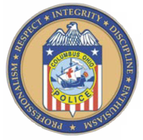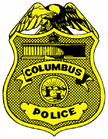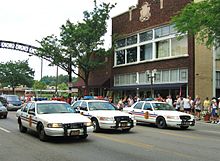- Columbus Division of Police
-
Columbus Division of Police Common name Columbus Police Abbreviation CPD Patch of the Columbus Division of Police. Logo of the Columbus Division of Police. Badge of the Columbus Division of Police. Motto Professionalism, Respect, Integrity, Discipline, Enthusiasm Agency overview Formed 1868 Employees 2,200+ Legal personality Governmental: Government agency Jurisdictional structure Operations jurisdiction* City of Columbus in the state of Ohio, USA Size 550.5 km² Population 787,033 General nature Operational structure Headquarters Columbus, Ohio Police Officers 1888 Civilians 310 Agency executive Walter Distelzweig, Chief of Police Subdivisions 5- Administrative, Investigative, Patrol North, Patrol South, Support Services
Facilities Precincts 20 Police Boats 11 Helicopters 6 Website Columbus Police Website Footnotes * Divisional agency: Division of the country, over which the agency has usual operational jurisdiction. The Columbus Division of Police is the main policing unit for the city of Columbus, Ohio. It is composed of 20 precincts, and the Chief of Police is Walter Distelzweig. Columbus is ranked the 8th most dangerous city in the United States of the 15 cities with a population of 700,000 or more, according to the FBI-based Morgan-Quitno rankings.[1] Special units of the Columbus Division of Police include a Helicopter Unit, Canine Unit, Mounted Unit, Bicycle Patrol Teams, Marine Park Unit, PoliceNET Operations Unit, and a Computer Forensics Unit.[2]
In 2003, there were 1,779 sworn police officers and 349 civilian staff. By 2006, the number rose to 1,822 sworn officers and 342 total civilian staff. The estimated total budget was $216,000,000 in 2005, which rose to $244,000,000 for 2007.[3]
Contents
Structure
Columbus Police has a total of five subdivisions. The subdivisions include the Administrative, Investigative, Support Services, and two Patrol subdivisions, East and West. Each subdivision is commanded by a Deputy Chief. The nature of each task to be performed determines which subdivision has responsibility and authority. As of 2007[update], the department has 484 marked patrol vehicles, 536 unmarked vehicles, 41 motorcycles, 60 bicycles, 11 boats, 8 horses, 9 canines, and 6 helicopters.[2]
Current rankings are as follows: (As of May 2009)
Chief of police 1 Deputy Chief 6 Commander 18 Lieutenant 56 Sergeant 227 Police Officer 1,850 Administrative Subdivision
The Administrative Subdivision currently commands a staff of 128 sworn and 86 civilian employees who conduct internal investigations, research and development, recruit and in-service training, inspections, legal matters, accreditation process, and business and personal administration. He also serves as the Division’s representative in labor-management concerns and as a liaison with City Hall.
Investigative Subdivision
The investigative Subdivision's Deputy Chief Antone P. Lanata commands a staff of 388 sworn and 50 civilian employees who primarily conduct in-depth investigations of crimes that, due to their nature or complexity, cannot be investigated by uniformed officers. This includes, but is not limited to, cases involving felony crimes against persons and property; a multitude of investigations involving juvenile offenders or victims; and covert investigations involving narcotics, vice, and intelligence concerns.
Support Services Subdivision
The Support Services Subdivision's Deputy Chief Gary Thatcher commands a staff of 197 sworn and 248 civilian employees. The Support Services Subdivision consists of a variety of specialized units that support the Division’s patrol and investigative activities. Among the services these units provide are communications and computer networks, helicopter air support, special weapons and tactics, court assistance, police records and identification, community liaison, and maintenance of the Division’s canine and motor vehicle fleet.
Patrol North Subdivision
The Patrol North Subdivision's Deputy Chief Stephen Gammill commands 579 sworn and 17 civilian personnel. The subdivision is composed of zone 1 (North) zone 4 (North central), and the Traffic Bureau. The Traffic Bureau commander oversees the Mounted Unit, Freeway Patrol Units, Traffic Control Unit, and the Accident Investigation Unit. The Bureau is responsible for the freeways, downtown traffic, residential area traffic, and the investigation of hit-skip and fatal crashes.
Patrol South Subdivision
The Patrol South Subdivision's Deputy Chief John M. Rockwell commands 448 sworn and three civilian employees. The subdivision is composed of zones 2 (Southeast), 3 (West), and 5 (Central). The subdivision's commander is Deputy Chief John M. Rockwell, and the three zones are divided into twelve precincts with officers working out of eight substations located throughout the eastern portion of the city.
Marked vehicles
Columbus Police cars serving special duty at the 2005 Doo Dah Parade.
The Columbus Police standard marked patrol fleet consists largely of Crown Victoria Police Interceptor models. Officers from the Strategic Response Bureau drive the Chevrolet Impala and zone Lieutenants drive the Ford Expedition. The Chevrolet Express is used as a Paddywagon. Additionally, the department is testing a Dodge Charger in its Freeway Patrol division.
Marked Vehicles can be identified by the numbered "license" plates. Two, three and four digit digit plates show the precinct number followed by the car number. Recently the CPD has begun transitioning to some four digit cruiser numbers to facilitate exceeding the 10 cars per precinct rule. 10 regular cars are assigned to any single precinct, so a plate bearing the number 55 is precinct-5 car-5; where plate 190 is precinct-19 car-10. Under the four digit car number car 1809 would be precinct 18 car 9. Vehicles outside the standard precinct structure, i.e. Freeway Patrol, and Motorcycle Patrol also follow this pattern, where their unit is given a unique "precinct" number. Marked vehicles with a four digit starting in "9" are "mid-watch" assignments with the same pattern for their respective precinct.
The letter "R" as a prefix to this system denotes a "relief car". Plate R-106 is used because the 10th precinct has a regular vehicle in maintenance or repair.
The letters "S" and "L" stand for Sergeant and Lieutenant and denote that vehicle assigned to that ranked officer assigned to the following numbered precinct or zone: S-12 is the Sergeant for precinct-12 and L-1 is the Lieutenant for Zone-1.
The letter "T" Denotes a "Training" vehicle and is assigned to the Police Academy
The letter "X" stands for eXtra. X-Cars are kept at the city fleet management facility and are available to officers for special duty.
In previous years, CPD utilized the Chevrolet Caprice, Plymouth Gran Fury and the Ford LTD II as cruisers.
Special Duty
Some police duties that are required by law or requested by the general public fall outside the realm of normal, everyday procedures. For example, Ohio Law requires that only a Law Enforcement Officer may close a public road, or a lane thereof, without establishing a legal, marked detour(for road closure), or using concrete barriers (for lane restrictions only). In the event of a short-term construction project, a law enforcement officer must be on site to legally close the area to traffic.[4]
Columbus Police are permitted to work "Special Duty" assignments, upon approval, while off duty. Special Duty assignments can include anything from closing highway lanes for short-term road construction, to directing traffic for events, escorting a funeral procession, or providing security for private businesses, such as banks or stores. Most special duty assignments are paid for by the organization requesting the officers presence. However, while on Special Duty, the officer works for the City of Columbus, regardless the posting, and can be called upon by On Duty personnel if needed.
See also
References
External links
Categories:- Law enforcement agencies of Ohio
- Organizations based in Columbus, Ohio
- Municipal police departments of Ohio
- Government of Columbus, Ohio
Wikimedia Foundation. 2010.






